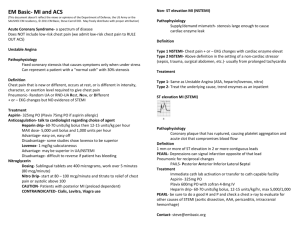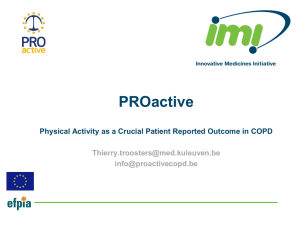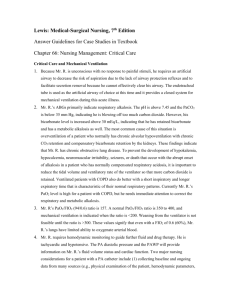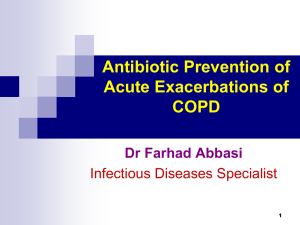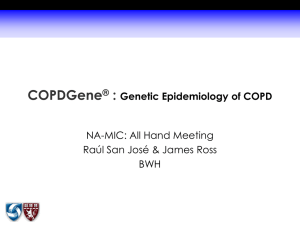Shortness of Breath show notes (Word format)
advertisement
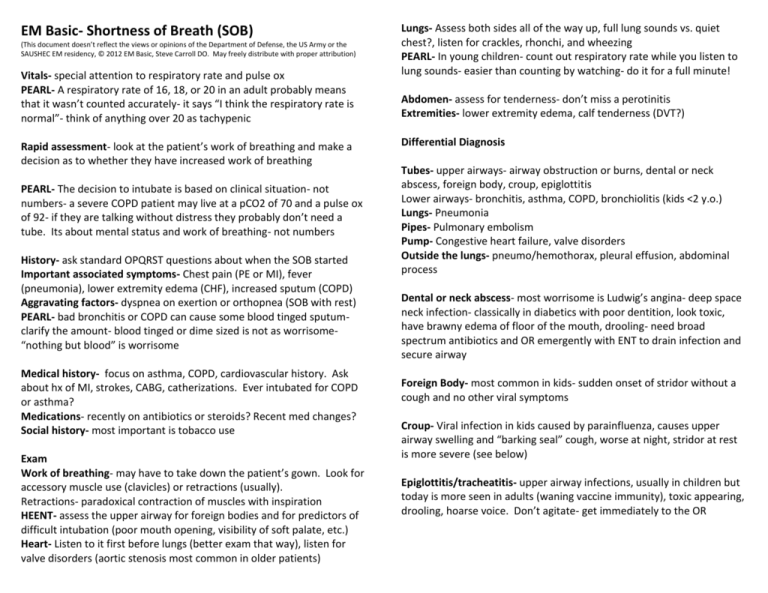
EM Basic- Shortness of Breath (SOB) (This document doesn’t reflect the views or opinions of the Department of Defense, the US Army or the SAUSHEC EM residency, © 2012 EM Basic, Steve Carroll DO. May freely distribute with proper attribution) Vitals- special attention to respiratory rate and pulse ox PEARL- A respiratory rate of 16, 18, or 20 in an adult probably means that it wasn’t counted accurately- it says “I think the respiratory rate is normal”- think of anything over 20 as tachypenic Rapid assessment- look at the patient’s work of breathing and make a decision as to whether they have increased work of breathing PEARL- The decision to intubate is based on clinical situation- not numbers- a severe COPD patient may live at a pCO2 of 70 and a pulse ox of 92- if they are talking without distress they probably don’t need a tube. Its about mental status and work of breathing- not numbers History- ask standard OPQRST questions about when the SOB started Important associated symptoms- Chest pain (PE or MI), fever (pneumonia), lower extremity edema (CHF), increased sputum (COPD) Aggravating factors- dyspnea on exertion or orthopnea (SOB with rest) PEARL- bad bronchitis or COPD can cause some blood tinged sputumclarify the amount- blood tinged or dime sized is not as worrisome“nothing but blood” is worrisome Medical history- focus on asthma, COPD, cardiovascular history. Ask about hx of MI, strokes, CABG, catherizations. Ever intubated for COPD or asthma? Medications- recently on antibiotics or steroids? Recent med changes? Social history- most important is tobacco use Exam Work of breathing- may have to take down the patient’s gown. Look for accessory muscle use (clavicles) or retractions (usually). Retractions- paradoxical contraction of muscles with inspiration HEENT- assess the upper airway for foreign bodies and for predictors of difficult intubation (poor mouth opening, visibility of soft palate, etc.) Heart- Listen to it first before lungs (better exam that way), listen for valve disorders (aortic stenosis most common in older patients) Lungs- Assess both sides all of the way up, full lung sounds vs. quiet chest?, listen for crackles, rhonchi, and wheezing PEARL- In young children- count out respiratory rate while you listen to lung sounds- easier than counting by watching- do it for a full minute! Abdomen- assess for tenderness- don’t miss a perotinitis Extremities- lower extremity edema, calf tenderness (DVT?) Differential Diagnosis Tubes- upper airways- airway obstruction or burns, dental or neck abscess, foreign body, croup, epiglottitis Lower airways- bronchitis, asthma, COPD, bronchiolitis (kids <2 y.o.) Lungs- Pneumonia Pipes- Pulmonary embolism Pump- Congestive heart failure, valve disorders Outside the lungs- pneumo/hemothorax, pleural effusion, abdominal process Dental or neck abscess- most worrisome is Ludwig’s angina- deep space neck infection- classically in diabetics with poor dentition, look toxic, have brawny edema of floor of the mouth, drooling- need broad spectrum antibiotics and OR emergently with ENT to drain infection and secure airway Foreign Body- most common in kids- sudden onset of stridor without a cough and no other viral symptoms Croup- Viral infection in kids caused by parainfluenza, causes upper airway swelling and “barking seal” cough, worse at night, stridor at rest is more severe (see below) Epiglottitis/tracheatitis- upper airway infections, usually in children but today is more seen in adults (waning vaccine immunity), toxic appearing, drooling, hoarse voice. Don’t agitate- get immediately to the OR Lower airway Asthma- usually a younger patient with wheezing and shortness of breath, on outpatient inhalers COPD- usually an older patient with a history of smoking, wheezing, and on outpatient inhalers Bronchiolitis- viral syndrome, wheezing, respiratory difficulty, bilateral runny nose in a child <2 years old Lungs Pneumonia- cough, fever, SOB, +/- hypoxia, chest x-ray with an infiltrate Pipes (blood vessels) Pulmonary embolism- sudden onset of pleuritic chest pain, shortness of breath, risk factors include OCPs, immobilization, recent surgery, etc. Pump (heart) Congestive heart failure- dyspnea on exertion with lower extremity edema, orthopnea, crackles on lung exam, “wet” chest x-ray MI- chest pain, diaphoresis, nausea, EKG changes Outside the lung (space occupying) Pneumothorax- spontaneous (thin tall young patient or bad COPD/asthma) or traumatic, air in chest cavity on CXR Hemothorax- traumatic- seen as a white out on the CXR Pleural effusion- layering fluid at bases on CXR Abdominal process- perotinitis, free air under diaphragm Workup- EKG and Imaging EKG- low threshold especially on older patients and in anyone with CHF or MI as a consideration (most patients over 40 should get one) Chest x-ray- Low threshold but can withhold it if it seems like an obvious asthma exacerbation or clear cut bronchiolitis PEARL- If patient is in distress or has chest pain, get a 1 view portable CXR at the bedside, otherwise send for a 2 view PA and lateral, 2 view is better, can’t tell cardiomegaly from 1 view CT Pulmonary Angiogram- if considering PE Workup- Labs In general- if you are going to send the patient home, don’t get labs (or at least don’t order them and send them), if you admit, get labs Venous blood gas- can be helpful in cases of severe SOB but don’t base airway interventions on those numbers alone CBC/Chem 10- in COPD and pneumonia patients that you are going to admit Blood cultures x2- Only in pneumonia patients, ? quality measure but this seems to change everyday, don’t order them unless you are admitting the patient to avoid culture callbacks. Can tell your nurse/tech to draw and hold if you are unsure whether the patient will be admitted CBC, chem 10, coags- PE workup patients (check creatinine for IV contrast, platelets and coags for possible anticoagulation) Cardiac Enzymes- Cardiac workup- CK, CK-MB, Troponin, +/- myoglobin BNP- secreted by the heart in response to increased ventricular stretch, <100- probably not CHF, >400- probably CHF 100-400 indeterminate Treatment Non-invasive Ventilation (CPAP and BiPAP)- can use to avoid intubation and reduce work of breathing, start at 10/5 and titrate upwards Asthma and COPD Beta Agonists- albuterol- 2.5 mg unit dose or 5mg continuous (child) or 10mg continuous (adult) Anticholinergic- ipatroprium (atrovent)- 1 dose during ED stay (1 dose lasts 4-6 hours, no benefit from higher dosing) Steroids- for both asthma and COPD Prednisone- 50mg PO for adults (5 day total course) Orapred (oral prednisolone)- 1 mg/kg PO BID for kids (5 day course) Solumedrol (IV prednisolone)-125 mg IV or 2mg/kg for kids PEARL- Bioavailability is the same PO vs. IV- only reason to give IV is if the patient is too tachypenic to take PO COPD flares- add antibiotics (anti-inflammatory effects) Outpatient- Azithromycin (Z-pack)- 500mg on day 1, 250 for days 2-5 Inpatient- Azithromycin or Levaqiun (levofloxacin)- 500mg IV Bronchiolitis treatment- mostly supportive Treatment- nasal suctioning and oxygen as needed PEARL- Beta agonists don’t help bronchiolitis PEARL- High risk bronchiolitis patients (need admission for apnea monitoring)- 12 bed PICU- <12 weeks old, Premature, Immunodeficient, Cardiac anomaly (congenital) Croup- mostly supportive Decadron (dexamethasone)- 0.6 mg/kg PO, max 10mg Racemic Epi neb- only for kids with stridor at rest (i.e. when NOT agitated or crying)- requires 4 hour observation period after neb The lungs Pneumonia- most common cause is strep pneumonia Treatment- antibiotics, oxygen as needed Adults- Community Acquired- outpatient- Azithromycin (Z-pack) Adults- Community Acquired- inpatient- ceftriaxone 1 gram IV and Azithromycin 500mg initial dose in ED Children- Community Acquired- outpatient- amoxicillin 45 mg/kg BID PEARL- Amoxicillin 400mg/5ml= 1 teaspoon for every 10 kg (like children’s acetiminophen/ibuprofen) Children- Community Acquired- inpatient- Ceftriaxone 50 mg/kg IV and azithromycin 10 mg/kg Hospital Acquired- see sepsis podcast The Pipes (blood vessels) Pulmonary embolism- heparin/enoxaparin - see chest pain podcast The Pump (heart) Congestive Heart Failure (CHF)- nitrates, Lasix Nitroglycerin- start with sublinguals (0.4 mg q 5 minutes= 80 mcg per minute), can do IV drip for more severe cases Lasix- loop diuretic- takes 4-6 hours for diuresis but is a weak venodilator (nitro much better)- 20mg IV or usual outpatient PO dose given IV. Outside the lungs Pneumo/hemothorax- drain using a chest tube Pleural effusion- consider draining but most will resolve if you treat the underlying condition Embasic.org Contact- steve@embasic.org Twitter- @embasic


